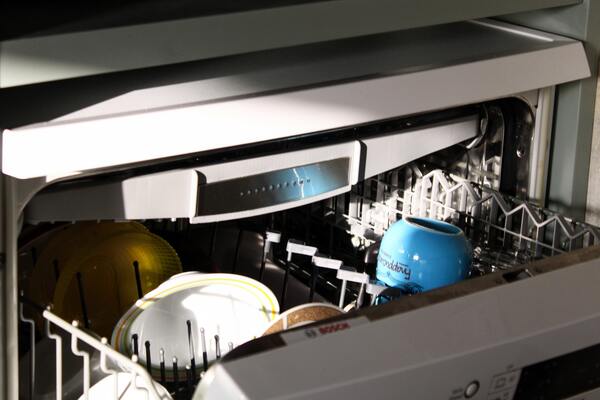It can all seem a little mysterious when you close a dishwasher’s door and hear the water begin to run. Do you ever wonder how a dishwasher operates? We will introduce how a dishwasher works in this article. And you can also learn some important information about your dishwasher.
Dishwasher Basics
Control Mechanism
Behind the control panel inside the door is where you’ll find the control mechanism. A straightforward electro-mechanical system is employed by many devices: a timer determines how long each part of the cycle lasts and activates the proper function at the proper time (such as the detergent dispenser, wash spray, and draining functions).
More expensive units may have a computerized control system. Additionally, modern units have a door latch that needs to be closed in order for them to operate. Many have locks with child safety features.
Water Intake Valve
The dishwasher is filled from the water supply of the house at this point. The valve, which is mounted inside the dishwasher, opens and closes to allow in the right amount of water during a cycle. The water pressure causes the valve to open, allowing water to enter the appliance.
Circulation Pump
The circulation pump has an electric motor. The pump pushes water up into the spray arms throughout the washing cycle. Pumping water into the drain hose is what happens when the drain cycle is running.
Located in the middle of the dishwasher, the pump assembly is mounted below the basin. There are two primary categories of pumps:
- Reversible. By rotating the motor in the opposite direction, these pumps can switch from pumping water to the drain to pumping water to the spray arms. Normal mounting for reversible pumps is vertical.
- Direct-drive. The motor in these pumps only rotates in one direction. So, the direction of the water flow switches from the spray arms to the drain pipe via a solenoid valve. Pumps with direct drives are typically mounted horizontally.
Dishwashers can be set up as either a portable or a fixed installation. Portable units have countertop-useable tops and finished sides. The device is placed next to the wall and is dormant when not in use.
When it’s time to run a cycle, the appliance can be moved on casters over to the sink, where it is plugged into an adjacent outlet and connected to the faucet.

How Does A Dishwasher Work
Pre-Wash/Rinse
the initial burst of warm water that runs through the spray arm, wetting all of the dirty dishes but not really cleaning much.
For when your dishes are really, really dirty, some dishwashers have a pre-wash detergent dispenser to give this cycle a little extra cleaning power. Usually, the pre-wash takes just a few minutes.
Main Wash
What it says on the tin: the main part of the wash cycle. The water is heated, heated, heated, heated, sprayed, collected, filtered, etc., until the heating unit is turned off, while the spraying continues. All of the water is drained following the primary wash.
The main wash, which may repeat several times throughout the cycle, can take anywhere from 20 to 60 minutes, depending on the cycle.
Final Wash And Rinse
The heating, spraying, filtering, and heating cycle is restarted by this component, which draws in fresh, clean water. The heater is eventually turned off while the spraying continues, just like with the main wash.
Detergent might or might not be used in the last wash and rinse. Similar to the primary wash, the final wash/rinse can take anywhere between 20 and 60 minutes and may be repeated several times throughout the cycle.
The three key phases of a cycle are clearly depicted by a graph of the temperature inside the dishwasher over time:
One warning should be mentioned in this context. Some dishwashers draw water directly from the source rather than having an integrated water heater, which means that whatever temperature water is currently flowing through the kitchen is used to wash the dishes.
Unclean dishes or detergent pods that haven’t completely dissolved may be the result of using cold water when washing. If this is the case, try turning on the hot water faucet in the kitchen sink to flush out the cold water, then shut it off once the dishwasher cycle has begun.
If the hot water at the kitchen sink is left on, it will draw hot water away from the dishwasher just when it is most needed.
Pre-wash/rinse, main wash, and final wash/rinse are the three main steps in your dishwasher’s cleaning cycle. Depending on the manufacturer, additional rinses, heated drying to dry your dishes, or other features may also take place.
Why Dishwashers Need Detergent
Liquid or solid (tablet-form) detergent is the other component that every dishwasher needs in order to effectively remove grease and grime from your dishes.
You put the detergent in a dispenser in the door, and at some point during the wash cycle, usually, after the machine first turns on, the dispenser flips open, letting the detergent fall or drip into the hot water bath at the bottom of the machine.
You can learn more about how detergents work in our article on detergents, which also explains how dishwasher detergents function.
In a nutshell, they are made up of a combination of ingredients for removing the various types of food deposits that are likely to be left on your cutlery and crockery, as well as water softeners, and chemicals to prevent rusting of the machine, and enticing scents.
Read more: Can You Put Drano In A Dishwasher?
Guidelines For Using A Dishwasher
- Typical dish soap should not be used. The dishwasher will be filled to the brim with suds.
- Make sure the dishwasher isn’t full. You must make room so that the dishes can be sprayed with water from the jets.
- The dishware should be oriented with the dirtiest portion facing the spray jets, which are typically located in the middle.
- Avoid combining stainless steel and sterling silver (or silver plate) objects. Corrosion or pitting is a given when two distinct types of metal are brought into contact in a moist environment.
- Keep bowls, spoons, and other items with similar shapes apart. Otherwise, they have a tendency to cluster together, making it impossible for the water to reach all of the dishes.
- Dishware made of wood, cast iron, fine china, crystal, or that has been hand-painted should not be put in the dishwasher. Hand washes these items.
- When the water pressure is at its highest, such as late at night, use the dishwasher. If you aren’t using much water for other things, like washing clothes, the dishwasher will clean more thoroughly.
- Use a little bit more detergent if your home has hard water.
- To prevent smudges and hasten dish drying, use a rinse aid.
- Plastics shouldn’t be placed on the bottom rack, especially if you plan to use the hot drying cycle. Some plastics may melt when the heating element is used.
- Do not clean the dishes. In fact, to keep the pH level in the dishwasher at the proper level, dishwashers rely on the food particles that stick to dirty dishes. But you ought to scrape the big pieces into the trash.





